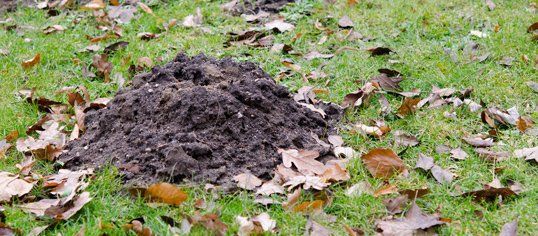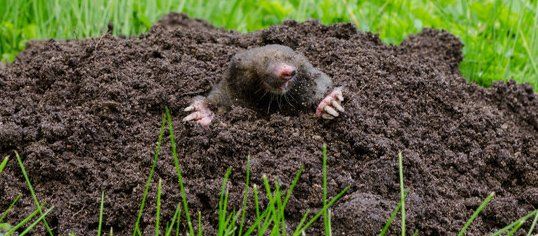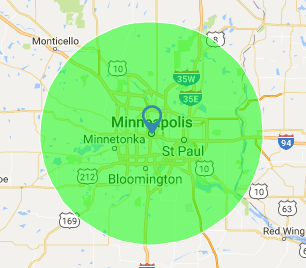Informative Facts on Moles
Moles and Their Occurrences
There are 7 species of moles in North America. There are 2 types in Minnesota — the star nosed and the eastern mole. In our area, we come across the eastern mole; its fur is short, silky, and silvery gray to grayish brown. Its tiny eyes are concealed in the fur and are covered by fused
eyelids. Its external ears are absent. An adult’s total length is between 5 to 8 inches, weighing 3 1/5 to 5 oz.

FAQs About Moles
Q. When do they breed?
A. The eastern mole breeds during early spring and has an average of 3 to 4 young once a year. Young moles
have 50% less chance of surviving to reproduce.
Q. What do they eat?
A. Its primary food source is earthworms, but they won't resist grubs or other insects. A mole will consume 45 to 50 pounds of worms and other insects each year. This can be 85% to 100% of their body weight each day.
Q. Can one mole cause all this damage?
A. Yes, a mole can exert a lateral digging force of up to 32 times their body weight. It can dig surface tunnels at approximately 18 feet an hour. Over the course of an 8-hour period, a mole can produce 144 feet of tunnel. This can add up to hundreds of yards of earth during its 3-year lifespan.
Q. What type of dirt do they dwell in?
A. Moles
are mostly found in organic soils and hardpan
clay.
Q. Do they have any predators?
A. Due to their subterranean habits and musky odor, few animals prey on them.
Q. When are they active?
A. They are active during the day and night. They have short resting periods.
Q. Do moles hibernate?
A. No, they're active all round the year.
Q. Are they feeding on my plants?
A. No. However, they're destroying the roots of these plants with their large front feet while digging for worms and other insects in and around the roots.
Q. Are they harming my landscape?
A. Yes, by undermining the earth below and allowing rain runoff to create even more damage through washouts and settling.
Q. Does castor oil or other remedies that I have heard of actually work?
A. No, this method may make the mole activity move from one part of the yard to another. This movement is affected by climate and ground moisture and not by sprays and other remedies. Because the mole's primary food source is earthworms, moisture plays an important role in their movements; this is why you'll see the mole activity rotate to different areas of the yard or even temporarily leave altogether to hunt food in another part of their territory. They show up when you least expect it. This particular behavior is the root cause of most of the misconceptions that make all these home remedies, pesticides, and poisons appear credible. You may also believe that these rumors regarding home remedies or control methods are worth trying, which isn't true. Here are just a few things our customers have already tried:
- Grub control
- Vehicle exhausts
- Ultrasonic devices
- Poisoned fake worms
- Chewing gum
- Garden hose
- Cayenne pepper
- Granular or pellet type poisons
- Smoke bombs
- Broken glass
- Castor beans
- Castor oil
- Mothballs
- Predator urine
NOTE: Poisons will work on pocket gophers, but we have found that to achieve a complete clearing, you'll need to use a trapping plan.
Q. Why should I do anything about these moles when they're just going to come back?
A. Not necessarily. Moles
reproduce at a relatively slow rate. The chances
of recurrences depend on the weather and the location of outlying territories. We should also keep in mind that every property is uniquely different.
The only way to effectively control moles is to trap and physically remove them. Successful trapping requires time, patience, knowledge of mole habits, and a thorough know-how of the trapping equipment being used.

University Links
Check out these links for more information on moles:
To get FREE estimates on all our pest removal services, call
S Metro 952-403-9223
N Metro 763-755-2569
For further details on moles and other rodents, call Suburban Wildlife Control Inc.



